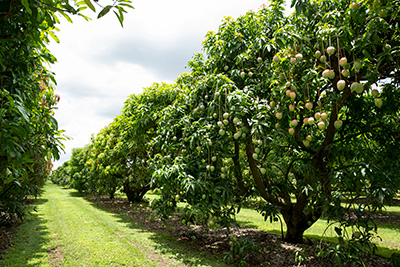Mango
It’s hard to beat the sweet flavor and juiciness of a ripe mango. These succulent tropical fruits come in a wide range of varieties and can be grown in the southern half of Florida.

Native to South Asia, mango trees grow best in hardiness zones 10B through 11. Their leaves are long and narrow, dark green, and shiny. In the spring, spikes of flowers appear, ranging in color from white to yellow to reddish-pink. The fruit is familiar to most, but mangos are variable in size and shape, and the color may be greenish-yellow, yellow with a red or purple blush or completely red. The sweet, juicy flesh is yellow to orange and sometime fibrous. The single seed is large, flat, and covered with a woody husk.
Some mango trees grow quite large, reaching up to 60 feet tall and 50 feet wide, so be sure you have ample space in your yard before planting one of these beauties. If you have limited space, try growing a small variety. One of their benefits is that they can be container-grown and moved indoors if you live in a colder corner of the state. Keep your container mango well-pruned to maintain a reasonable size.
In general, mango trees should be planted in full sun. Select a part of the landscape away from other trees, buildings and structures, and power lines. Select the warmest area of the landscape that does not flood (or remain wet) after typical summer rains.
Mango trees will need occasional pruning, fertilization, and treatment for pests. Depending upon the variety, fruit may be harvested from May through August, so you can enjoy this sweet treat all summer long.
Some recommended varieties for home growing include ‘Fairchild,’ ‘Rosigold,’ ‘Glenn,’ ‘Angie’ and ‘Orange Sherbet.’ See Table 1 in “Mango Growing in the Florida Home Landscape” for a larger list of mango varieties suggested for home gardens.

